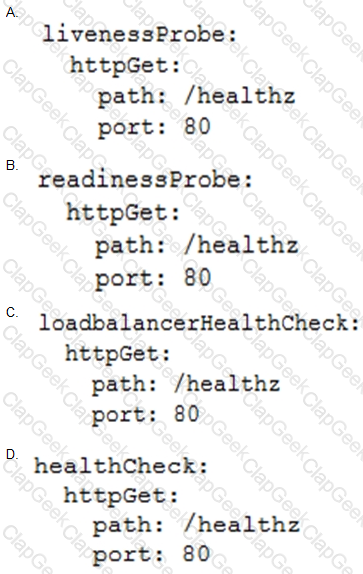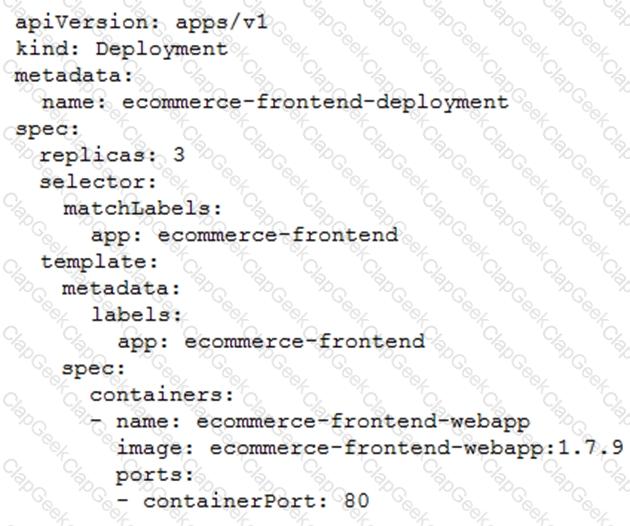You are responsible for deploying a new API. That API will have three different URL paths:
• https://yourcompany.com/students
• https://yourcompany.com/teachers
• https://yourcompany.com/classes
You need to configure each API URL path to invoke a different function in your code. What should you do?
Your development team has been asked to refactor an existing monolithic application into a set of composable microservices. Which design aspects should you implement for the new application? (Choose two.)
You are developing an internal application that will allow employees to organize community events within your company. You deployed your application on a single Compute Engine instance. Your company uses Google Workspace (formerly G Suite), and you need to ensure that the company employees can authenticate to the application from anywhere. What should you do?
You need to deploy an internet-facing microservices application to Google Kubernetes Engine (GKE). You want to validate new features using the A/B testing method. You have the following requirements for deploying new container image releases
• There is no downtime when new container images are deployed.
• New production releases are tested and verified using a subset of production users.
What should you do?
You are developing a microservice-based application that will be deployed on a Google Kubernetes Engine cluster. The application needs to read and write to a Spanner database. You want to follow security best practices while minimizing code changes. How should you configure your application to retrieve Spanner credentials?
You are planning to deploy your application in a Google Kubernetes Engine (GKE) cluster The application
exposes an HTTP-based health check at /healthz. You want to use this health check endpoint to determine whether traffic should be routed to the pod by the load balancer.
Which code snippet should you include in your Pod configuration?

Your security team is auditing all deployed applications running in Google Kubernetes Engine. After completing the audit, your team discovers that some of the applications send traffic within the cluster in clear text. You need to ensure that all application traffic is encrypted as quickly as possible while minimizing changes to your applications and maintaining support from Google. What should you do?
You are designing an application that consists of several microservices. Each microservice has its own RESTful API and will be deployed as a separate Kubernetes Service. You want to ensure that the consumers of these APIs aren't impacted when there is a change to your API, and also ensure that third-party systems aren't interrupted when new versions of the API are released. How should you configure the connection to the application following Google-recommended best practices?
You are developing an application hosted on Google Cloud that uses a MySQL relational database schema. The application will have a large volume of reads and writes to the database and will require backups and ongoing capacity planning. Your team does not have time to fully manage the database but can take on small administrative tasks. How should you host the database?
Your company has a new security initiative that requires all data stored in Google Cloud to be encrypted by customer-managed encryption keys. You plan to use Cloud Key Management Service (KMS) to configure access to the keys. You need to follow the "separation of duties" principle and Google-recommended best practices. What should you do? (Choose two.)
You are working on a social media application. You plan to add a feature that allows users to upload images. These images will be 2 MB – 1 GB in size. You want to minimize their infrastructure operations overhead for this feature. What should you do?
You want to re-architect a monolithic application so that it follows a microservices model. You want to
accomplish this efficiently while minimizing the impact of this change to the business.
Which approach should you take?
You recently developed an application that monitors a large number of stock prices. You need to configure Pub/Sub to receive a high volume messages and update the current stock price in a single large in-memory database The downstream service needs only the most up-to-date prices in the in-memory database to perform stock trading transactions Each message contains three pieces of information
• Stock symbol
• Stock price
• Timestamp for the update
.
How should you set up your Pub/Sub subscription?
You are developing an application that will allow users to read and post comments on news articles. You want to configure your application to store and display user-submitted comments using Firestore. How should you design the schema to support an unknown number of comments and articles?
Your application is deployed in a Google Kubernetes Engine (GKE) cluster. When a new version of your application is released, your CI/CD tool updates the spec.template.spec.containers[0].image value to reference the Docker image of your new application version. When the Deployment object applies the change, you want to deploy at least 1 replica of the new version and maintain the previous replicas until the new replica is healthy.
Which change should you make to the GKE Deployment object shown below?

You are planning to deploy your application in a Google Kubernetes Engine (GKE) cluster. Your application
can scale horizontally, and each instance of your application needs to have a stable network identity and its
own persistent disk.
Which GKE object should you use?
In order for HipLocal to store application state and meet their stated business requirements, which database service should they migrate to?
For this question, refer to the HipLocal case study.
HipLocal's application uses Cloud Client Libraries to interact with Google Cloud. HipLocal needs to configure authentication and authorization in the Cloud Client Libraries to implement least privileged access for the application. What should they do?
For this question, refer to the HipLocal case study.
HipLocal is expanding into new locations. They must capture additional data each time the application is launched in a new European country. This is causing delays in the development process due to constant schema changes and a lack of environments for conducting testing on the application changes. How should they resolve the issue while meeting the business requirements?
HipLocal’s data science team wants to analyze user reviews.
How should they prepare the data?
For this question, refer to the HipLocal case study.
Which Google Cloud product addresses HipLocal’s business requirements for service level indicators and objectives?
HipLocal is configuring their access controls.
Which firewall configuration should they implement?
For this question, refer to the HipLocal case study.
A recent security audit discovers that HipLocal’s database credentials for their Compute Engine-hosted MySQL databases are stored in plain text on persistent disks. HipLocal needs to reduce the risk of these credentials being stolen. What should they do?
HipLocal has connected their Hadoop infrastructure to GCP using Cloud Interconnect in order to query data stored on persistent disks.
Which IP strategy should they use?
HipLocal wants to reduce the number of on-call engineers and eliminate manual scaling.
Which two services should they choose? (Choose two.)
For this question refer to the HipLocal case study.
HipLocal wants to reduce the latency of their services for users in global locations. They have created read replicas of their database in locations where their users reside and configured their service to read traffic using those replicas. How should they further reduce latency for all database interactions with the least amount of effort?
HipLocal's.net-based auth service fails under intermittent load.
What should they do?
HipLocal's APIs are showing occasional failures, but they cannot find a pattern. They want to collect some
metrics to help them troubleshoot.
What should they do?
For this question, refer to the HipLocal case study.
How should HipLocal increase their API development speed while continuing to provide the QA team with a stable testing environment that meets feature requirements?
In order to meet their business requirements, how should HipLocal store their application state?
HipLocal wants to improve the resilience of their MySQL deployment, while also meeting their business and technical requirements.
Which configuration should they choose?
For this question, refer to the HipLocal case study.
How should HipLocal redesign their architecture to ensure that the application scales to support a large increase in users?
Your company has deployed a new API to App Engine Standard environment. During testing, the API is not behaving as expected. You want to monitor the application over time to diagnose the problem within the application code without redeploying the application.
Which tool should you use?
You have a container deployed on Google Kubernetes Engine. The container can sometimes be slow to launch, so you have implemented a liveness probe. You notice that the liveness probe occasionally fails on launch. What should you do?


